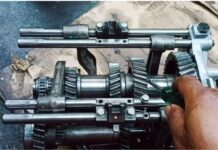When we talk about a car’s design, most people focus on the front look or whether it has a sporty side profile. But let’s not overlook the importance of the rear end.
Think about this scenario: you spot an amazing car heading your way. You pause, admire, and watch it closely – until it zooms past you. What’s left for you to see? Its shrinking backside.
The rear view of a car leaves a lasting impression. It’s the final image that sticks with you. That’s exactly why car designers throughout history have always tried to give their vehicles a unique touch, especially when it comes to tail-lights.
In this article, we dive into 29 classic cars that boast tail-lights which are anything but ordinary.
1. Tucker Torpedo (1948)
The Tucker Torpedo, also known as the Tucker 48, is a prime example of a missed opportunity in automotive history.
Preston Tucker, the founder of the company, grew up in Detroit, a city synonymous with the automobile industry. His passion for cars was undeniable, and he even pursued a career in law enforcement because it allowed him to indulge in his love for high-speed driving.
However, his aspirations reached far beyond being a police officer. He dreamed of creating his own car, one that would stand out with a distinctive design, and the Tucker Torpedo was born.
What set the Torpedo apart right from the start was its futuristic appearance, earning it the nickname “cyclops car” due to its unique and eye-catching design. But it wasn’t just the aesthetics that made it special; it also featured a substantial flat-six engine positioned at the rear. Interestingly, this same engine found its way into another notable vehicle, the Bell 47 helicopter.
Preston Tucker’s vision for the Tucker Torpedo was indeed ahead of its time, leaving us to wonder what could have been if this innovative car had become more than just a fascinating concept.
2. Volkswagen Beetle (1945-2003)
The Volkswagen Beetle boasts an impressive 58-year lifespan, which undoubtedly contributes to its legendary status as a classic car today.
Designed by none other than Ferdinand Porsche (yes, that Porsche) in the 1930s, the Beetle didn’t enter series production until the end of World War II and continued to roll off assembly lines until 2003.
What made the Beetle so iconic was its clever design. It appeared small on the outside, but inside, it offered surprising roominess and practicality. Moreover, it aimed to be cost-effective to operate and maintain, and its relatively aerodynamic shape played a role in achieving this goal.
One of the standout features that we appreciate about the Beetle is its seemingly simple yet undeniably stylish rear lights.
The Beetle’s design left a lasting impact, influencing other manufacturers to adopt the rear-engined, rear-wheel-drive layout, most notably seen in Chevrolet’s Corvair. However, concerns over the Corvair’s handling did impact its sales.
Over the years, the Beetle saw engine size increases, but the commitment to cost-efficiency remained unwavering.
It gained immense popularity, not only as a standard vehicle but also as the foundation for countless kit cars. One of the most famous examples is the Beach Buggy, which owes its existence to the adaptable Beetle platform.
3. Chevrolet Bel Air Mk2 (1955-’57)
The second-generation Chevy Bel Air capitalizes on the growing fascination with fins among American car buyers during that era.
In addition to its front grille, which drew inspiration from Ferrari, the Bel Air sported two prominent fins at the rear. These fins led to the introduction of some distinctive tail-light designs cleverly integrated into the rear bumper.
Interestingly, this design lasted for just one year. In 1956, the Italian-inspired front grille vanished, and the rear lights were consolidated into a single unit. What’s noteworthy is that the left-hand rear light also concealed the fuel filler.
Under the hood, buyers had various engine options, including 3.5-liter (216.5 cubic inches) and 3.9-liter (235.5 cubic inches) straight-six engines, as well as a 4.3-liter (265 cubic inches) V8.
In 1957, Chevrolet upsized the engine to 4.6 liters (283 cubic inches) and even introduced a mechanical fuel-injection system. It’s no wonder that Chevrolet marketed the Bel Air as ‘The Hot One,’ given its impressive performance and style.
4. Facel Vega HK500 (1959-’62)
The name Facel had been around since 1939, initially as a supplier of aircraft industry components. However, in 1954, the company shifted its focus from the skies to the ground by venturing into car manufacturing.
Their debut car was unveiled at the 1954 Paris Auto Show. Sporting a long bonnet and two distinctive tail fins, it was designed with both European and, notably, American markets in mind.
These distinctive tail fins featured integrated tail-lights and even included reversing lights seamlessly incorporated into the rear panel. This design, exemplified by the HK500 model pictured here, exudes a sense of style.
In line with its target markets, Facel Vega opted for a range of V8 engines sourced from the United States. By the time the HK500 hit the road, these engines had already reached an impressive 335 horsepower, reflecting the company’s commitment to performance.
5. Cadillac Eldorado Mk4 (1959-’60)
The name “Eldorado” is derived from the Spanish “El Dorado,” which translates to “The Gilded One.” This name certainly suits the Cadillac Eldorado, as it is undeniably a massive, gleaming behemoth of a car.
There were two versions of the Eldorado. The Seville was a hardtop model, while the Biarritz was the convertible variant. Both epitomize the term “land yacht” because they were enormous vehicles designed to provide an exceptionally serene and comfortable journey.
These cars came exceptionally well-equipped, featuring automatic transmission, power steering, two-speed wipers, electric windows, adjustable seats, air suspension, and central locking.
One of their most distinctive features was the enormous rear-wing fins that housed the distinctive ‘rocket-ship’ tail-lights, as seen in the image above. Additionally, there was a grille running across the width of the car’s rear, mirroring the one on the front of the vehicle.
However, in 1960, Cadillac decided to tone down the rear styling, reducing the size of the fins and integrating the rear lights more seamlessly. Some enthusiasts may lament this change.
6. Chevrolet El Camino Mk1 (1959-’60)
In 1957, Ford gained an edge over Chevrolet by introducing the Ranchero, a pickup truck based on a coupe platform. Chevrolet needed to respond, and they did so by taking the platform from the newly designed Brookwood two-door estate and creating an appealing pickup body for it.
Chevrolet marketed the result as the El Camino, emphasizing that it was their first pickup with a steel load-bed floor, a departure from the traditional wooden ones. Interestingly, if you removed the bed’s 26 retaining screws, you would find the Brookwood estate’s floorpan underneath, complete with rear passenger footwells.
The El Camino also featured stylish horizontal fins and distinctive lights that cut through the tailgate. Customers were quick to show their approval, with the Chevrolet outselling the Ford in its debut year by nearly 50%.
It’s no surprise considering the El Camino’s performance. With the potent 5.7-liter (348 cubic inches) V8 engine, it could go from 0 to 60 mph in around 7 seconds.
However, by 1960, buyers were shifting away from the El Camino, prompting Chevrolet to discontinue the original model after just two years.
7. Lincoln Continental Mk3 Convertible (1959-’60)
Ford had grand ambitions for its Lincoln brand, positioning it as a direct competitor to prestigious luxury marques like Rolls-Royce and Bentley. This vision led to the creation of the Mk2 Continental, designed with those high-end competitors in mind.
However, this bold move didn’t yield the desired results, and it’s believed that Ford incurred losses of at least $1000 on every Continental Mk2 sold.
Recognizing the need for a change in approach, Lincoln adjusted its goals for the Mk3 and set its sights on Cadillac, General Motors’ luxury brand. The company developed an enormous bodyshell, making it one of the longest convertibles ever produced in the United States. They adorned it generously with chrome accents at both ends and incorporated a stylish trio of lamps on each side of the car’s rear, as depicted here.
Under the hood, the Mk3 boasted a 7-liter (430 cubic inches) V8 engine that transmitted power to the rear wheels through a three-speed automatic gearbox. This setup delivered the kind of commanding and smooth performance that one would expect from a luxury vehicle of its caliber.
8. Chevrolet Corvette C1 (1953-’62)
In early 1953, Chevrolet faced a significant challenge. The return of many servicemen from overseas led to a demand for sports cars, but Chevrolet had nothing in its lineup to meet this demand. As a result, people were importing foreign sports cars like Alfa Romeos and MGs, which was not good for Chevy’s business.
To address this issue, Chevrolet embarked on the development of its own sports car. The result of this effort was the Ex-122 prototype, which served as the foundation for the Corvette C1. In late 1953, this prototype was unveiled to the public, and it received an enthusiastic response. Production commenced, even though the final car ended up being more expensive than initially planned.
The Corvette C1 was a small and agile sports car, but it still embraced some of the stylistic trends of the 1950s. Notably, it featured two prominent fins at the rear, complete with protruding bullet tail-lights.
Despite its initial popularity, the Corvette faced challenges in terms of sales. It struggled due to its basic specifications and somewhat sluggish performance, largely attributed to its 3.9-liter (235 cubic inches) straight-six engine.
However, General Motors persevered with the Corvette, and in 1955, they introduced a more potent 4.3-liter (265 cubic inches) V8 engine. This significant improvement helped change people’s perceptions of the Corvette, securing its future as an iconic American sports car.
9. Dodge Polara Mk1 (1960-’61)
In the 1950s, people in America had grown tired of the austerity that had characterized post-war automotive design for many years. With the advent of the rock and roll era, they were eager for a change, and car manufacturers had to adapt quickly to meet this demand.
Enter Virgil Exner, a stylist at Dodge, who set out to create a car that would capture attention. His creation was the 1960 Dodge Polara, featuring some seriously large rear fins.
Now, you might think, “What’s so special about fins? Many other cars had them.” But these fins on the Polara were perched atop long ‘jet-pod’ tubes, with the tail-lights positioned at their ends. If any vehicle embodied the spirit of the burgeoning jet age, it was the Dodge Polara. It exuded a sense of glamour and the promise of an exciting, yet-to-be-discovered future.
While the Polara’s design was undeniably futuristic, its engine was not quite as cutting-edge. It housed a 6.3-liter (383 cubic inches) V8 engine, coupled with a three-speed automatic transmission. This powertrain gave the Polara a majestic engine note and the smooth ride akin to a luxurious yacht.
10. Plymouth Valiant Mk1 (1960-’62)
During the 1950s, the US automobile industry adhered to the mantra that “bigger is better.” However, as the decade drew to a close, car manufacturers had to come to terms with the fact that consumers were open to smaller options as long as they were more affordable.
In response, Plymouth embarked on the design and production of a smaller sedan and estate car called the Valiant. The goal was to compete with smaller, budget-friendly newcomers like the VW Beetle.
Designers crafted a shape for the Valiant that resonated with buyers, setting it apart from the similar Chrysler Falcon. It featured distinctive rear light designs on both the four-door and estate (Station Wagon) models, adding to its appeal.
Under the hood, the Valiant boasted a six-cylinder, 2.8-liter (170 cubic inches) engine. This engine not only offered more power but also greater fuel efficiency compared to the straight-six engines found in some of its competitors. Some versions even came equipped with ‘Captive-Aire’ tires, a precursor to today’s run-flat tires.
11. Ford Cortina Mk1 (1962-’66)
The Ford Cortina was conceived as a car that would cater to the growing demand for four-wheeled transportation in early 1960s Britain. To achieve mass appeal, it needed to be fuel-efficient, economical to operate, and, crucially for Ford, cost-effective to manufacture.
The Cortina was introduced in various body styles, including two- and four-door saloons, as well as a five-door estate. It featured a distinctive and easily recognizable design with sculpted sides and rear lights that bore a striking resemblance to the insignia of the Campaign for Nuclear Disarmament (CND).
Ford recognized that involvement in motor racing could inject a dose of excitement and glamour into a model primarily aimed at everyday drivers. Thus, a year after the standard Cortina’s launch, the Ford Cortina Lotus was introduced. This performance-oriented variant was equipped with a Lotus 1.6-liter engine and various chassis enhancements.
The unique three-spoke tail-lights remained a defining feature, leaving a lasting impression on competitors and enthusiasts alike.
12. Rover P6 (1963-’77)
In the early 1960s, Rovers were vehicles coveted by affluent older businessmen, often referred to as the “bowler-hat-and-cane brigade.” Notably, this demographic primarily consisted of men.
However, as the business landscape rapidly evolved, a younger generation of ambitious professionals entered the scene. They didn’t find the traditional, upright Rovers as appealing.
In response to these changing dynamics, Rover introduced the P6, a car with a significantly more aggressive and modern appearance. It featured sharp angles, a wide and sleek profile, and offered impressive performance.
Rover, however, was not eager to completely abandon its traditional customer base. Therefore, both the new P6 and its predecessor, the P5, were sold side by side until the older model was eventually phased out in 1973.
The P6’s sleek design struck a chord with buyers, and it remained in production until 1977 when it was succeeded by the Rover SD1.
Nevertheless, the P6 faced its share of issues, many stemming from production challenges during the turbulent 1970s. In fact, there were reports of one example being so unreliable that it spent a significant portion of its early days in Rover workshops, tallying up 114 out of its first 165 days there.
13. Ford Mustang Mk1 (1964-’73)
What’s the longest-standing name in Ford’s history? Is it Cortina? No. Escort? Nope. Fiesta? Guess again. Surprisingly, the honor goes to the Mustang, a name that’s been a part of Ford’s lineup since 1964.
The Mustang owes its existence to a project initiated by Ford’s Lee Iacocca. He tasked the company’s three design studios with creating a car that met specific criteria: it had to be under five meters in length, accommodate four people with front bucket seats, feature a floor-mounted gearshift, weigh less than 1100 kilograms (2425 pounds), and utilize mechanical components from existing models.
One of the design studios developed what would eventually become the Mustang, although it was initially named the Cougar within that studio. This design featured a characteristic long hood and a short rear end, essentially giving birth to the “pony car” movement.
In its very first year, the Mustang achieved stardom on the silver screen. Tilly Masterson, a Bond girl, drove a white Ford Mustang convertible (unfortunately, it met an unfortunate end with its sill being shredded) in the film Goldfinger.
14. Mazda Cosmo 110S (1967-’72)
Mazda has had a long-standing association with the rotary engine dating back to the 1960s, and the Cosmo played a pivotal role in establishing this connection.
It was the first car to feature a two-rotor rotary engine, which garnered popularity among Japanese buyers. They appreciated the engine’s ability to deliver impressive power while being categorized as only 982cc, making it eligible for a lower annual road tax fee.
The Cosmo’s futuristic styling also appealed to customers, with its sleek design, faired-in headlamps, a long horizontal swage line, and tail-lights that were uniquely bisected by the rear bumper.
Internationally, it was known as the 110S due to its 110bhp power output. Beyond its stylish appearance and innovative engine, the Cosmo was celebrated for its reliability.
In fact, Mazda even entered two nearly stock Cosmo cars in the grueling 1968 Marathon de la Route race at the Nürburgring in Germany. This punishing 84-hour race saw one car retire after 81 hours due to an axle issue, while the second car persevered, completing the event and securing an impressive fourth-place finish.
15. Mercury Cougar Mk1 (1967-’70)
In the United States, coupés used to be immensely popular among consumers. When Mercury introduced the Cougar in 1967, it made quite an impact, accounting for nearly 40% of the Lincoln-Mercury division’s total sales for that year.
This is a remarkable achievement, considering that the Cougar was exclusively offered as a two-door hardtop.
Mechanically, it shared its underpinnings with the Ford Mustang, although it featured a 3-inch extended wheelbase. Initially, buyers could choose between a 4.7-liter (289 cubic inches) V8 engine or a 6.4-liter (390 cubic inches) V8. However, as time went on, high-performance models and special editions offered larger and more powerful V8 engines.
The Cougar’s distinctive appearance was a standout feature, sporting vacuum-operated vertically slatted headlight covers and a similar treatment at the rear end, as seen in the image above.
This generation of the Cougar enjoyed significant popularity, with annual sales surpassing 100,000 cars for three of its four years on the market.
16. Range Rover Mk1 (1969-’94)
The Land-Rover Series models were renowned for their ruggedness and capability, making them the favorites of the farming world. They could effortlessly conquer challenging terrains, whether it was scaling a rock face or navigating through a muddy field. However, despite their robustness, they lacked the comfort that many people desired.
This became a problem when American companies like Ford and Jeep were raking in substantial profits by selling models like the Ford Bronco and Jeep Wagoneer, which offered both toughness and comfort.
In 1970, Land Rover introduced the two-door Range Rover as a response to this changing landscape. It featured a modern and angular design, highlighted by wraparound rear-light units, a split tailgate (a feature that would become popular in its target market), and a 3.5-liter Rover V8 engine up front.
The Range Rover was acclaimed as one of the world’s first vehicles that excelled both off-road and on-road, marking the beginning of a motoring dynasty.
17. Dodge Charger Mk2 (1968-’70)
This generation of the Dodge Charger is quite rare today, and part of the reason for its desirability can be attributed to a certain television show that featured a bright orange-painted Charger. This has significantly increased its appeal among collectors and enthusiasts.
However, the Charger’s journey to its iconic status was not a straightforward one. It was first introduced in 1966 and 1967 as part of the Dodge Coronet family, featuring a distinctive fastback rear end. Unfortunately, it didn’t find much favor with buyers, partly due to its unique styling and the prevailing popularity of smaller and more powerful pony cars.
When the second-generation Charger was launched, it took on a more conventional two-door body design with a traditional trunk at the back. The new model also sported aggressive twin circular tail-light units, replacing the full-width light bar seen in the previous version.
A significant boost to its reputation came when it shared the spotlight with Steve McQueen in the film Bullitt, undoubtedly helping boost its sales. In fact, Dodge had to ramp up production significantly to keep up with the surging demand for the Charger.
18. Ford Cortina Mk3 (1969-’76)
Ford in Europe underwent a significant period of consolidation at the beginning of the 1970s. This led to the merger of Ford of Britain and Ford of Germany, forming the entity known as Ford of Europe. As a result, their product lines needed to harmonize as well.
In this context, the Ford Cortina Mk3 and Ford Taunus platforms became almost identical. During the development phase, the car was referred to as the TC1, blending the names Taunus and Cortina.
The car embraced the popular ‘Coke-bottle’ styling characteristic of the era. This design featured rising curves behind the rear doors and a sculpted full-width rear panel, creating the illusion of space between the square rear light units.
Early sales faced challenges, primarily due to production issues, exacerbated by a 10-week strike at Ford’s production facilities, which severely impacted the number of cars they could manufacture.
Nonetheless, the Cortina made a strong comeback in 1971, bolstered by its modern attributes compared to immediate rivals. In 1972, it claimed the title of the best-selling car in Britain, a distinction it held for four consecutive years.
19. Hillman Avenger Mk1 (1970-’79)
The Hillman Avenger holds a unique place in automotive history for a couple of reasons.
Firstly, it was the sole car developed by Hillman following its acquisition by Chrysler in 1967. Secondly, it earned the distinction of being the first British car to feature a full-width plastic front grille.
In terms of aesthetics, the Avenger was quite appealing, especially considering the market and the era it belonged to. It embraced the trendy ‘Coke bottle’ styling, reminiscent of the Ford Cortina Mk3, and sported distinctive ‘hockey stick’ rear-light units curving around the edge of the bootlid.
The Avenger lineup offered various models, including the sporty GT with twin front headlights and eye-catching go-faster stripes.
Notably, the fleet version of the car had some functional differences, like a single-speed fan and the absence of a passenger sunvisor.
However, in 1976, Hillman underwent full acquisition by Chrysler, leading to a facelift for the Avenger. Unfortunately, this redesign meant bidding farewell to the curved rear-light units that had been a signature feature of the earlier models.
20. Vauxhall Firenza (1971-’75)
Coupés have a certain cool factor and can add a touch of excitement to an otherwise ordinary car lineup. They also tend to be cost-effective to produce when they share mechanical components with their more conventional counterparts. Ford capitalized on this with the Capri, and Vauxhall followed suit with the Firenza.
The Firenza essentially took the Viva saloon and estate cars and transformed them into a stylish two-door coupé with a sleek fastback body design. It notably featured twin front headlights.
Beyond the body style, the Firenza retained the core elements of the Viva, which was a plus because the third-generation Viva had a distinctive slim tail-light bar that elegantly curved around the car’s corner.
In 1973, Vauxhall took things up a notch by introducing a high-performance ‘droop snoot’ version of the Firenza. This variant boasted a distinctive glass-reinforced plastic nose reminiscent of the Ferrari Daytona, along with a tuned 2.3-liter four-cylinder engine. While sales of this model were relatively modest, its unique droop-snoot styling left a lasting impact and even influenced the design of subsequent Vauxhall models like the Chevette and Cavalier.
21. Mercedes-Benz 116-series S-Class (1972-’80)
The Mercedes S-Class has long been celebrated as the pinnacle of luxury in the automotive world. What’s less known to many is that Mercedes often uses the S-Class to debut cutting-edge luxury and safety technologies.
For instance, in 1978, this generation of the S-Class introduced the world to four-channel anti-lock brakes, a significant advancement in automotive safety.
It also featured the distinctive ridged tail-light covers that became a signature element of many Mercedes models throughout the 1970s, ’80s, and even into the ’90s.
But were these rear-light covers merely a stylistic choice to make it unmistakably clear that you were following a Mercedes-Benz? Not at all. They served a practical purpose by reducing the buildup of dirt while driving, ensuring that the lights remained visible and effective.
This exemplifies the S-Class ethos – not just about luxury but also about pushing the boundaries of safety technology, even if it’s as subtle as a light cover.
22. Lancia Stratos (1973-’78)
In the world of rallying, the rules had been relatively straightforward until 1973. Typically, rally cars were based on regular production vehicles. These cars would have their luxury features stripped away, undergo tuning, and receive upgrades like larger suspension and brakes to prepare them for the challenging rally stages.
However, Lancia had grander ambitions. Instead of conforming to the established norms, they aimed to build a supercar from the ground up that could fully exploit the rally regulations.
Enter the Lancia Stratos.
This remarkable car was unique in many ways. It was notably compact, nearly as wide as it was long, and it boasted a mid-mounted 2.4-liter Ferrari V6 engine.
The Stratos featured distinctive bodywork, consisting of a central cab section with front and rear clamshells that covered various components at both ends. The engine was positioned behind the cabin. Notably, the rear view of the Stratos was unlike anything else, with eye-catching circular light units, wide tires, and twin exhausts.
The concept proved to be a resounding success. The Stratos secured the World Rally Championship titles in 1974, ’75, and ’76. Unfortunately, despite its achievements, the Stratos fell out of favor due to internal politics within the Fiat group, which owned Lancia.
23. Lamborghini Countach (1974-’90)
When it comes to following in the footsteps of a legend like the Lamborghini Miura, the challenge is undeniably significant. The Miura had earned its reputation as the world’s first true supercar, setting a high bar for any successor.
However, Italian design firm Bertone rose to the occasion with the creation of the Lamborghini Countach. While the Miura exuded curves and elegance, the Countach took a different path, embracing an angular, sharp, and aggressive design.
One of the standout features of the Countach was its iconic upward-swiveling doors, instantly earning it cool points in the eyes of enthusiasts.
Initially, the Lamborghini Countach was equipped with a 3.9-liter V12 engine. As time went on, its engine size was increased to 5.2 liters, ensuring it could compete with newer performance rivals.
What set the Countach apart were its distinctive tail-lights: a trio of lights housed within angular pods on either side of the car’s rear end.
Regrettably, later versions of the Countach introduced bodywork additions that somewhat obscured the purity of the original car’s design.
24. Maserati Khamsin (1974-’82)
Let’s address one thing upfront – the Maserati Khamsin may not be known for having particularly eye-catching rear lights. So, you might wonder why it’s being featured here.
Well, the reason is that while the light units themselves might not be striking (they were, in fact, simple rectangular units shared with other models like the Merak, Bora, and even the De Tomaso Pantera), it was the way they were incorporated that made them stand out.
In the Khamsin, these lights were embedded in a glass panel that extended across the entire rear of the car, creating a visually unique effect of them appearing to ‘float’ as you followed the car.
Granted, Maserati seemed to prioritize style over potential security concerns, as this design allowed anyone to peek into the car to see if there was anything worth pilfering. Nonetheless, there’s no denying that it added a cool touch to the car’s aesthetics.
It’s regrettable that U.S. buyers didn’t experience the full Khamsin effect, as regulations required the rear lights to be relocated from the glass panel and mounted on top of the rear bumper. Both Maserati and designer Bertone strongly opposed this change, believing it detracted from the car’s rear-end aesthetics, but their efforts to overturn the ruling were unsuccessful.
25. Pontiac Firebird Trans Am Mk2 (1970-’81)
The Pontiac Firebird made quite a splash from the moment it hit the market, thanks to its sleek pony car design featuring a long hood and a short rear end, which gave it a well-proportioned and attractive look.
One of the distinctive design elements of the Firebird was its rear lights. Positioned far apart, these small light units at the back captured the essence of the era perfectly.
However, as the 1970s progressed and the Firebird underwent several facelifts, Pontiac decided to introduce an element of mystique to the car’s rear end. They did away with the separate light units and opted for a single black Perspex band that stretched across the entire width of the vehicle. While this design change added an element of intrigue, it had the downside of making the brake lights slightly less bright compared to the earlier models.
Unfortunately, as time went on, the Firebird’s performance suffered due to increasingly stringent emissions regulations. Despite its stylish appearance, it couldn’t deliver the same level of performance it once had.
Even though the Trans Am version gained fame through its appearance in the 1977 film “Smokey and the Bandit,” the later Firebird used in “Smokey and the Bandit II” had to be equipped with nitrous oxide tanks to achieve the necessary performance for the movie’s stunt crews.
26. Porsche 911 (1974-’89)
The Porsche 911 had cemented its status as one of the world’s most instantly recognizable sports cars, known for its distinctive upright cabin, somewhat weighty-looking tail, and front and rear light units that gracefully wrapped around each corner of the bodywork.
However, as is often the case in the automotive world, changes become necessary. In 1974, Porsche made some styling adjustments to accommodate new ‘impact’ bumpers required by U.S. authorities.
While the rear light units retained a familiar appearance, they were now accompanied by a Perspex band that prominently displayed the word ‘Porsche.’
These updates had the potential to disrupt the car’s aesthetics, but Porsche managed to execute a brilliant stylistic maneuver. As a result, the later models have become highly sought-after and are almost as beloved as their earlier counterparts.
27. Ferrari Testarossa (1984-’91)
If there was ever a car that perfectly embodied the spirit of its era, it was the Ferrari Testarossa. As the world emerged from the austerity of the 1970s and plunged headlong into the “more, more, more” ethos of the 1980s, the Testarossa arrived as a 12-cylinder symbol of excess and extravagance.
Under its long and elegant bonnet resided a formidable 4.9-liter flat-12 engine that unleashed 385 horsepower and 361 lb-ft of torque, offering performance that could make even a Lamborghini Countach driver pause for thought.
One of the Testarossa’s most striking features was its distinctive side scoops, which were enormous and featured long strakes along their length, a design choice that sparked some controversy at the time.
The Testarossa was also a wide car, measuring nearly two meters in width. This width was further accentuated by the horizontal strakes that extended across the entire rear of the vehicle, concealing the rear light units beneath them. From the rear view, it appeared as if the car had colossal shoulder pads—a look that perfectly encapsulated the fashion trends of the 1980s.
28. Maserati 3200GT (1998-2002)
The introduction of the Maserati 3200GT couldn’t have come at a better time. It marked the successor to the aging Shamal, a model that had been on the market since 1990 and was based on a design from a decade earlier. Despite its seemingly unassuming name, the 3200GT paid homage to Maserati’s first-ever grand-touring model, the 3500GT.
The 3200GT had a significant task ahead—to make a lasting impression in the automotive world. To achieve this, the car’s designers came up with a tail-light treatment that was truly distinctive and unlike anything else on the road.
The rear lights of the 3200GT were arranged in a unique ‘boomerang’ shape, following the curve of the car’s rear bodywork. The outer edge of this boomerang served as the brake light, while the inner edge functioned as the indicators. Notably, the 3200GT was the world’s first car to utilize LED light units, setting a new trend in automotive lighting technology.
29. BMW Z8 (1998-2003)
The BMW Z8 was not just a striking concept car; it actually made its way onto the streets. The project kicked off in 1993 with a clear goal: to create a car that would pay homage to the iconic BMW 507 roadster from the 1950s. The initial concept, known as the Z07, was unveiled at the 1997 Tokyo Motor Show, and it received an overwhelmingly positive response. This enthusiastic reception prompted BMW to take the concept to production.
Under the hood, the Z8 boasted a potent 4.9-liter V8 engine capable of delivering 395 horsepower. When combined with the lightweight aluminum chassis and body, this powerplant allowed the Z8 to accelerate from 0 to 62 mph in just 4.7 seconds—an impressive feat for its time.
One of the distinctive design features of the Z8 was its rear end, where sleek light units seamlessly blended into the bodywork. What made these lights unique was that they were constructed using neon tubes rather than traditional lightbulbs. This innovation not only provided a quicker response but was also touted to last the lifetime of the vehicle.


















![10 Countries With the Best Healthcare in the World [Statistical Analysis] Countries With the Best Healthcare in the World](https://articleify.com/wp-content/uploads/2025/07/Countries-With-the-Best-Healthcare-in-the-World-1-150x150.jpg)










